Down hill control HYUNDAI GENESIS GV70 2022 Owners Manual
[x] Cancel search | Manufacturer: HYUNDAI, Model Year: 2022, Model line: GENESIS GV70, Model: HYUNDAI GENESIS GV70 2022Pages: 647, PDF Size: 49.91 MB
Page 16 of 647
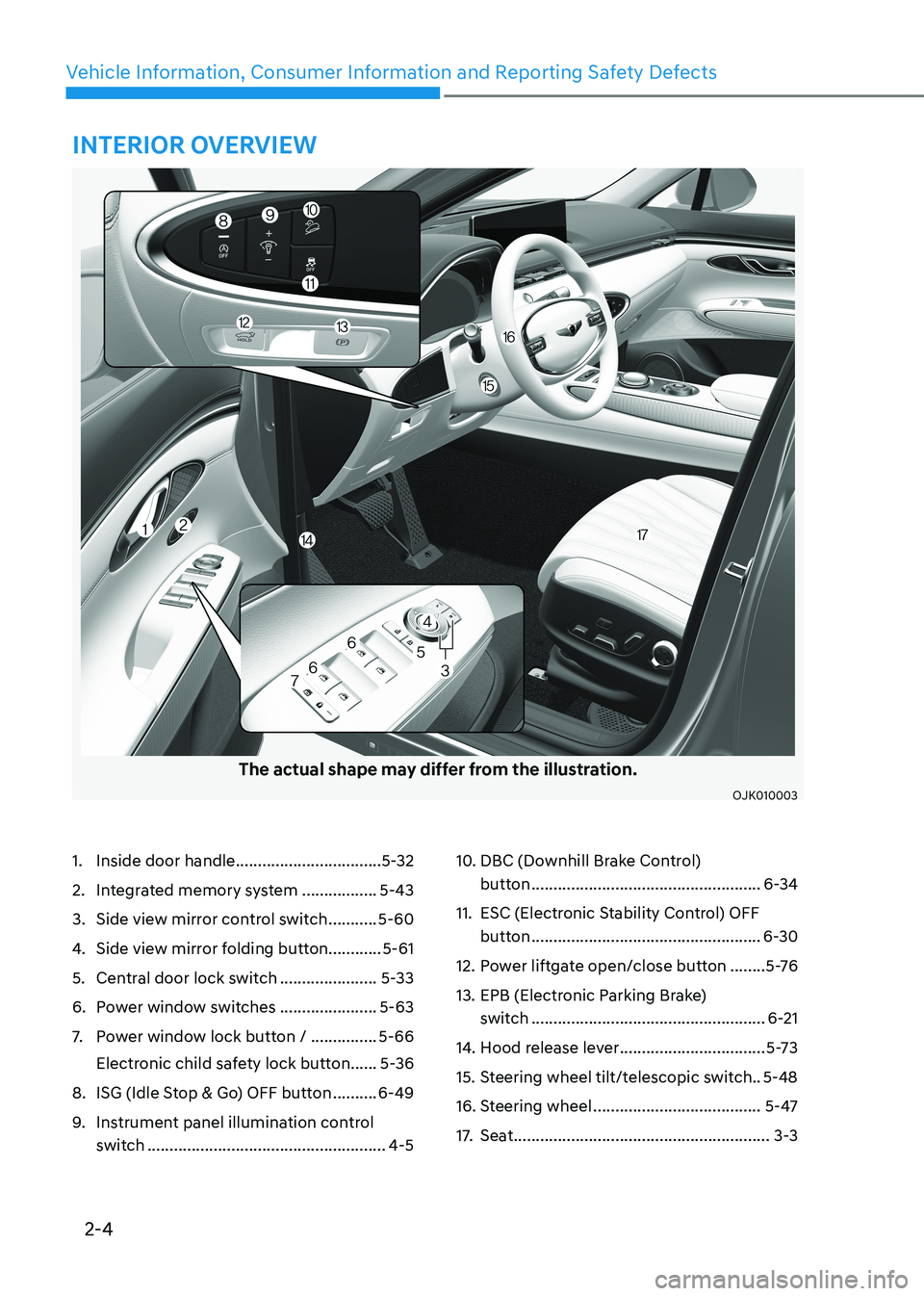
2-4
Vehicle Information, Consumer Information and Reporting Safety Defects
The actual shape may differ from the illustration.
OJK010003OJK010003
1. Inside door handle .................................5-32
2. Integrated memory system .................5-43
3. Side view mirror control switch ...........5-60
4. Side view mirror folding button............5-61
5. Central door lock switch ......................5-33
6. Power window switches ......................5-63
7. Power window lock button / ...............5-66
Electronic child safety lock button ......5-36
8. ISG (Idle Stop & Go) OFF button ..........6-49
9. Instrument panel illumination control
switch ......................................................4-5
10. DBC (Downhill Brake Control)
button ....................................................6-34
11. ESC (Electronic Stability Control) OFF
button ....................................................6-30
12. Power liftgate open/close button ........5 -76
13. EPB (Electronic Parking Brake)
switch .....................................................6-21
14. Hood release lever .................................5-73
15. Steering wheel tilt/telescopic switch..5-48
16. Steering wheel ......................................5-47
17. Seat ..........................................................3-3
INTERIOR OVERVIEW
Page 98 of 647
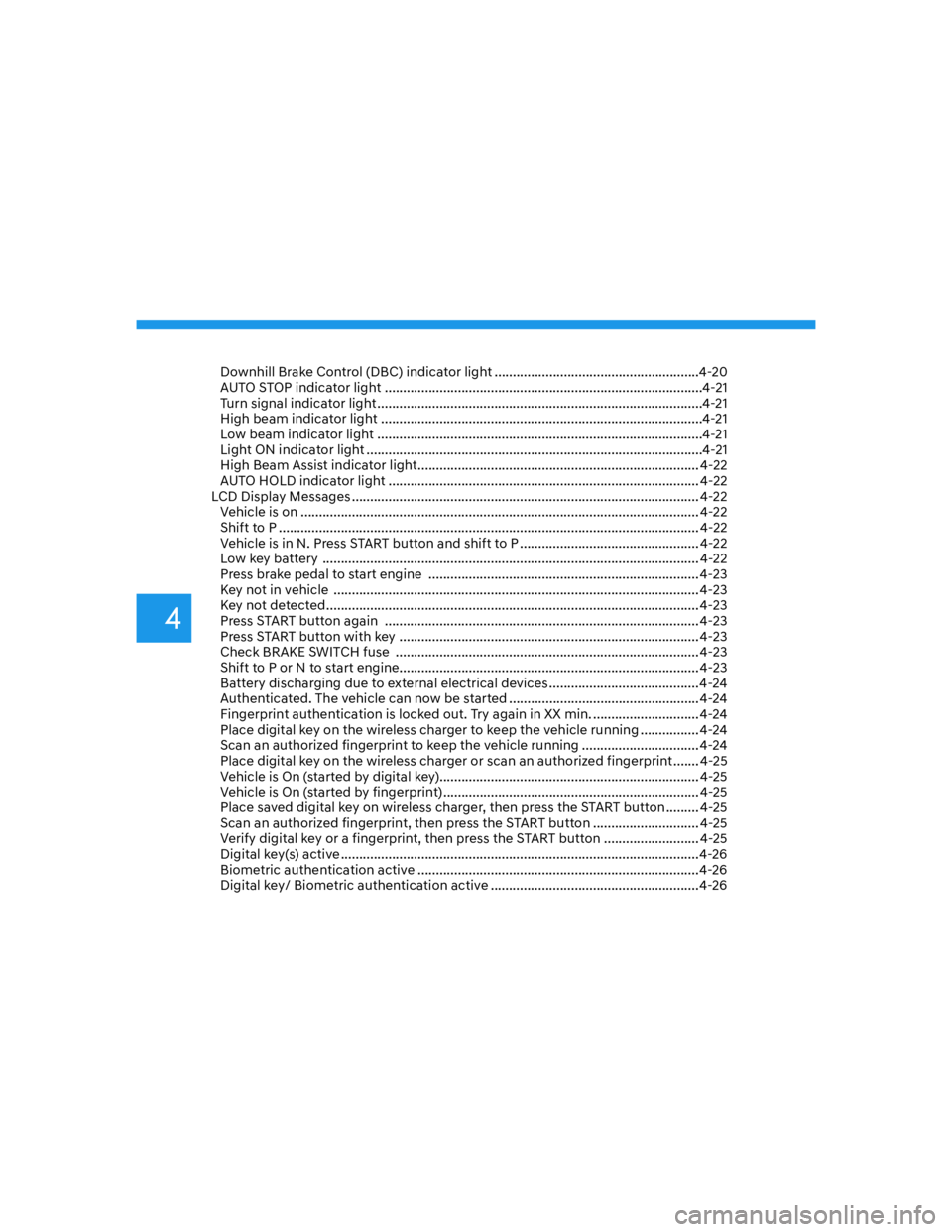
4
Downhill Brake Control (DBC) indicator light ........................................................4-20
AUTO STOP indicator light .......................................................................................4-21
Turn signal indicator light .........................................................................................4-21
High beam indicator light ........................................................................................4-21
Low beam indicator light .........................................................................................4-21
Light ON indicator light ............................................................................................4-21
High Beam Assist indicator light ............................................................................. 4-22
AUTO HOLD indicator light ..................................................................................... 4-22
LCD Display Messages ............................................................................................... 4-22
Vehicle is on ............................................................................................................. 4-22
Shift to P ................................................................................................................... 4-22
Vehicle is in N. Press START button and shift to P ................................................. 4-22
Low key battery ....................................................................................................... 4-22
Press brake pedal to start engine .......................................................................... 4-23
Key not in vehicle .................................................................................................... 4-23
Key not detected ...................................................................................................... 4-23
Press START button again ...................................................................................... 4-23
Press START button with key .................................................................................. 4-23
Check BRAKE SWITCH fuse ................................................................................... 4-23
Shift to P or N to start engine .................................................................................. 4-23
Battery discharging due to external electrical devices ......................................... 4-24
Authenticated. The vehicle can now be started .................................................... 4-24
Fingerprint authentication is locked out. Try again in XX min. ............................. 4-24
Place digital key on the wireless charger to keep the vehicle running ................ 4-24
Scan an authorized fingerprint to keep the vehicle running ................................ 4-24
Place digital key on the wireless charger or scan an authorized fingerprint ....... 4-25
Vehicle is On (started by digital key)....................................................................... 4-25
Vehicle is On (started by fingerprint) ...................................................................... 4-25
Place saved digital key on wireless charger, then press the START button ......... 4-25
Scan an authorized fingerprint, then press the START button ............................. 4-25
Verify digital key or a fingerprint, then press the START button .......................... 4-25
Digital key(s) active ..................................................................................................4-26
Biometric authentication active .............................................................................4-26
Digital key/ Biometric authentication active .........................................................4-26
Page 116 of 647
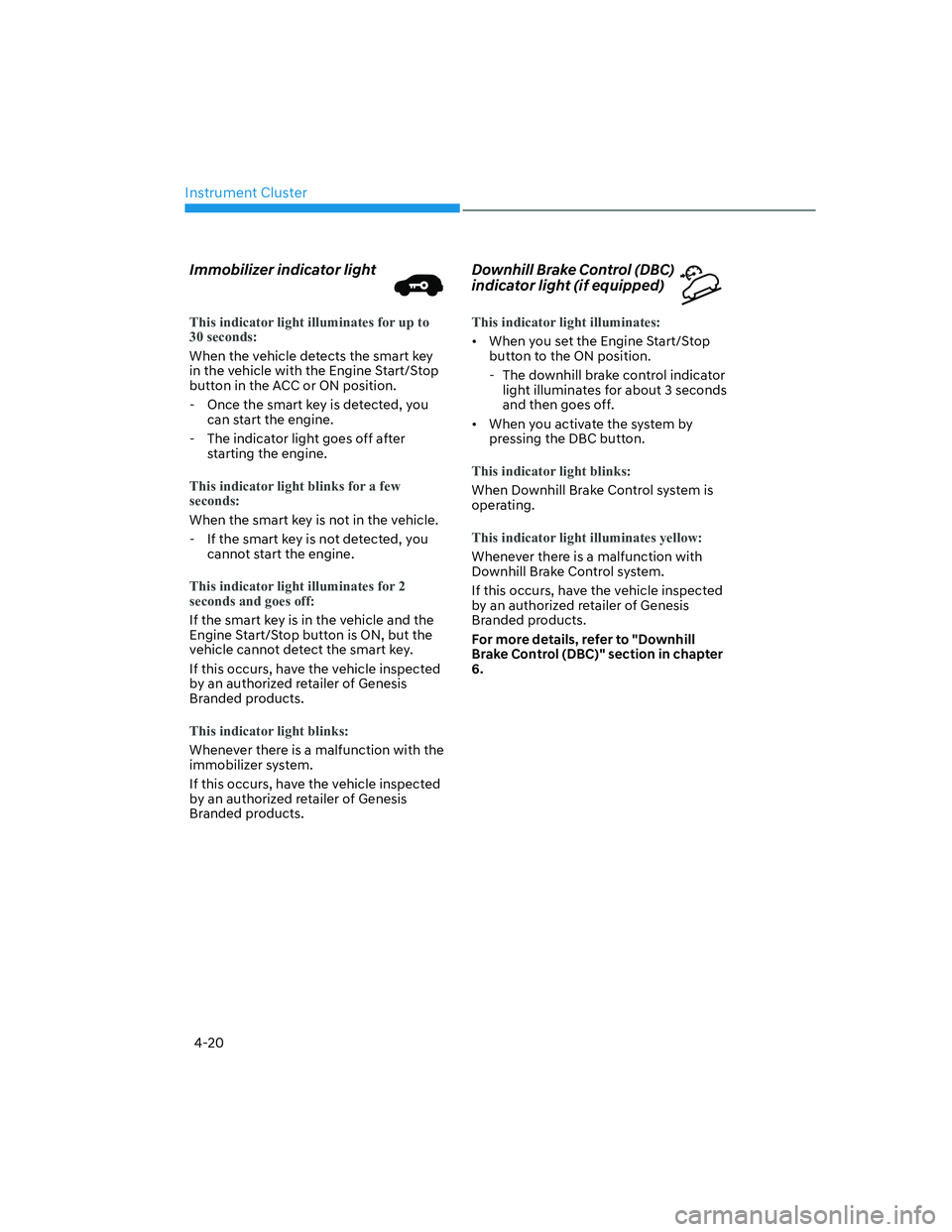
Instrument Cluster
4-20
Immobilizer indicator light
This indicator light illuminates for up to
30 seconds:
When the vehicle detects the smart key
in the vehicle with the Engine Start/Stop
button in the ACC or ON position.
- Once the smart key is detected, you
can start the engine.
- The indicator light goes off after
starting the engine.
This indicator light blinks for a few
seconds:
When the smart key is not in the vehicle.
- If the smart key is not detected, you
cannot start the engine.
This indicator light illuminates for 2
seconds and goes off:
If the smart key is in the vehicle and the
Engine Start/Stop button is ON, but the
vehicle cannot detect the smart key.
If this occurs, have the vehicle inspected
by an authorized retailer of Genesis
Branded products.
This indicator light blinks:
Whenever there is a malfunction with the
immobilizer system.
If this occurs, have the vehicle inspected
by an authorized retailer of Genesis
Branded products.
Downhill Brake Control (DBC)
indicator light (if equipped)
This indicator light illuminates:
• When you set the Engine Start/Stop
button to the ON position.
- The downhill brake control indicator
light illuminates for about 3 seconds
and then goes off.
• When you activate the system by
pressing the DBC button.
This indicator light blinks:
When Downhill Brake Control system is
operating.
This indicator light illuminates yellow:
Whenever there is a malfunction with
Downhill Brake Control system.
If this occurs, have the vehicle inspected
by an authorized retailer of Genesis
Branded products.
For more details, refer to "Downhill
Brake Control (DBC)" section in chapter
6.
Page 275 of 647
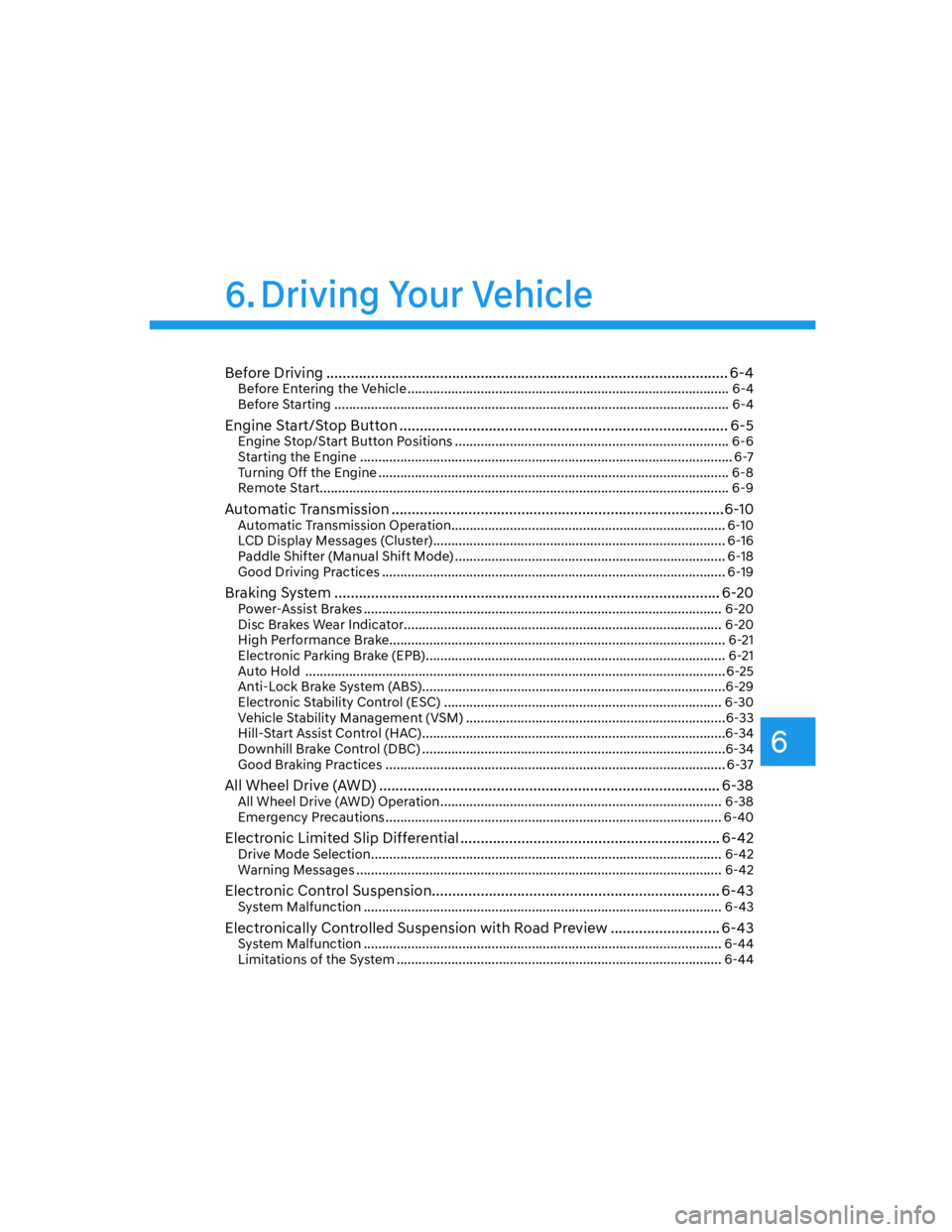
6
Before Driving ................................................................................................... 6-4Before Entering the Vehicle ........................................................................................ 6-4
Before Starting ............................................................................................................ 6-4
Engine Start/Stop Button ................................................................................. 6-5
Engine Stop/Start Button Positions ........................................................................... 6-6
Starting the Engine ...................................................................................................... 6-7
Turning Off the Engine ................................................................................................ 6-8
Remote Start ................................................................................................................ 6-9
Automatic Transmission ..................................................................................6-10
Automatic Transmission Operation ........................................................................... 6-10
LCD Display Messages (Cluster) ................................................................................ 6-16
Paddle Shifter (Manual Shift Mode) .......................................................................... 6-18
Good Driving Practices .............................................................................................. 6-19
Braking System ............................................................................................... 6-20Power-Assist Brakes .................................................................................................. 6-20
Disc Brakes Wear Indicator....................................................................................... 6-20
High Performance Brake............................................................................................ 6-21
Electronic Parking Brake (EPB) .................................................................................. 6-21
Auto Hold ................................................................................................................... 6-25
Anti-Lock Brake System (ABS) ...................................................................................6-29
Electronic Stability Control (ESC) ............................................................................ 6-30
Vehicle Stability Management (VSM) .......................................................................6-33
Hill-Start Assist Control (HAC) ...................................................................................6-34
Downhill Brake Control (DBC) ...................................................................................6-34
Good Braking Practices ............................................................................................. 6-37
All Wheel Drive (AWD) .................................................................................... 6-38All Wheel Drive (AWD) Operation ............................................................................. 6-38
Emergency Precautions ............................................................................................ 6-40
Electronic Limited Slip Differential ................................................................ 6-42Drive Mode Selection ................................................................................................ 6-42
Warning Messages .................................................................................................... 6-42
Electronic Control Suspension ....................................................................... 6-43System Malfunction .................................................................................................. 6-43
Electronically Controlled Suspension with Road Preview ........................... 6-43System Malfunction .................................................................................................. 6-44
Limitations of the System ......................................................................................... 6-44
6. Driving Your Vehicle
Page 285 of 647

06
6-11
WARNING
To reduce the risk of serious injury or
death:
• ALWAYS check the surrounding
areas near your vehicle for people,
especially children, before shifting a
vehicle into D (Drive) or R (Reverse).
• Before leaving the driver's seat,
always make sure the vehicle is
shifted to the P (Park) position, then
apply the parking brake, then press
the Engine Start/Stop button to
the OFF position. Unexpected and
sudden vehicle movement can occur
if these precautions are not followed.
• When using the paddle shifter
(manual shift mode), do not use
engine braking (shifting from a
high gear to lower gear) rapidly on
slippery roads. The vehicle may slip
causing an accident.
Rotary shifter/Rotary gear shift dial
P (Park)
Always come to a complete stop before
shifting into P (Park).
OJK060003OJK060003
To shift the gear to P (Park), press the P
button while depressing the brake pedal.
If you turn the engine off in R (Reverse),
N (Neutral) or D (Drive), the gear will
automatically shift to P (Park).
WARNING
• Shifting into P (Park) while the
vehicle is in motion may cause you to
lose control of the vehicle.
• After the vehicle has stopped, always
make sure the vehicle is in P (Park),
apply the parking brake, and turn the
engine off.
• When parking on an incline, shift
the gear to P (Park) and apply the
parking brake to prevent the vehicle
from rolling downhill.
Page 293 of 647

06
6-19
Good Driving Practices
• Never shift the gear from P (Park) or
N (Neutral) to any other position with
the accelerator pedal depressed.
• Never shift the gear into P (Park) when
the vehicle is in motion.
Be sure the vehicle is completely
stopped before you attempt to shift
into R (Reverse) or D (Drive).
• Do not shift the gear to N (Neutral)
when driving. If the gear is shifted to
N (Neutral) while driving, the vehicle
loses the ability to provide engine
braking. Doing so may increase the
risk of an accident.
Also, shifting the gear back to
D (Drive) while the vehicle is
moving may severely damage the
transmission.
• When driving uphill or downhill,
always shift to D (Drive) for driving
forward or shift to R (Reverse) for
driving rearwards. After selecting
D (Drive) or R (Reverse), check the
gear position indicated on the cluster
before driving. If the vehicle moves in
the opposite direction of the selected
gear, the engine may turn off and
affect braking performance that may
lead to a serious accident.
• Do not drive with your foot resting
on the brake pedal. Even light, but
consistent pedal pressure can result
in the brakes overheating, brake wear
and possibly even brake failure.
• Always apply the parking brake when
leaving the vehicle. Do not depend on
placing the transmission in P (Park) to
keep the vehicle from moving.
• Exercise extreme caution when
driving on a slippery surface. Be
especially careful when braking,
accelerating or shifting gears. On a
slippery surface, an abrupt change
in vehicle speed can cause the drive
wheels to lose traction and may cause
loss of vehicle control resulting in an
accident.
• Optimum vehicle performance and
economy is obtained by smoothly
depressing and releasing the
accelerator.
WARNING
To reduce the risk of SERIOUS INJURY
or DEATH:
• ALWAYS wear your seat belt. In a
collision, an unbelted occupant
is significantly more likely to be
seriously injured or killed than a
properly belted occupant.
• Avoid high speeds when cornering or
turning.
• Do not make quick steering wheel
movements, such as sharp lane
changes or fast, sharp turns.
• The risk of rollover is greatly
increased if you lose control of your
vehicle at highway speeds.
• Loss of control often occurs if two or
more wheels drop off the roadway
and the driver over steers to reenter
the roadway.
• In the event your vehicle leaves
the roadway, do not steer sharply.
Instead, slow down before pulling
back into the travel lanes.
• Genesis Branded Vehicle
recommends you to follow all posted
speed limits.
NOTICE
Kickdown mechanism
Use the kickdown mechanism for
maximum acceleration. Depress the
accelerator pedal beyond the pressure
point. The automatic transmission will
shift to a lower gear depending on the
engine speed.
Page 294 of 647
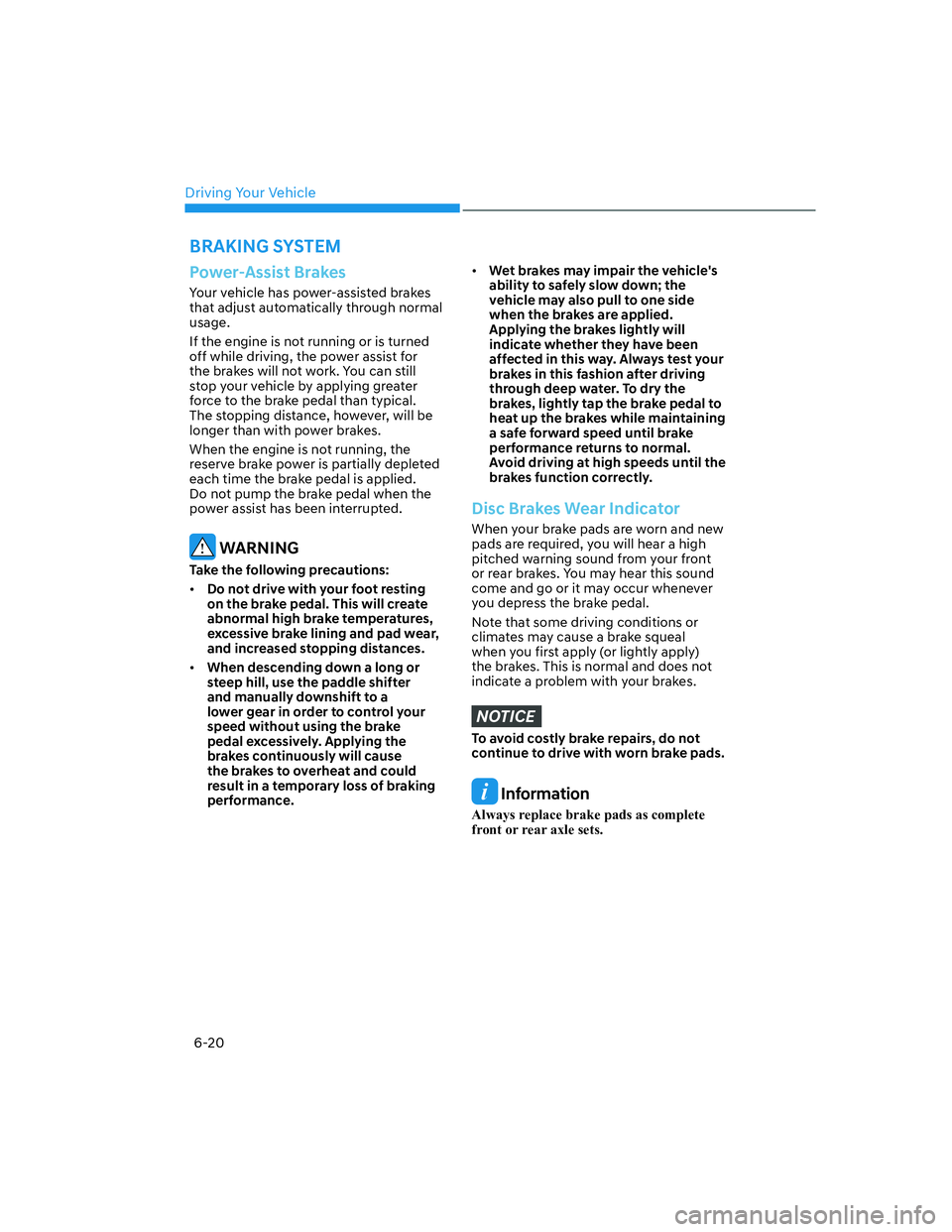
Driving Your Vehicle
6-20
Power-Assist Brakes
Your vehicle has power-assisted brakes
that adjust automatically through normal
usage.
If the engine is not running or is turned
off while driving, the power assist for
the brakes will not work. You can still
stop your vehicle by applying greater
force to the brake pedal than typical.
The stopping distance, however, will be
longer than with power brakes.
When the engine is not running, the
reserve brake power is partially depleted
each time the brake pedal is applied.
Do not pump the brake pedal when the
power assist has been interrupted.
WARNING
Take the following precautions:
• Do not drive with your foot resting
on the brake pedal. This will create
abnormal high brake temperatures,
excessive brake lining and pad wear,
and increased stopping distances.
• When descending down a long or
steep hill, use the paddle shifter
and manually downshift to a
lower gear in order to control your
speed without using the brake
pedal excessively. Applying the
brakes continuously will cause
the brakes to overheat and could
result in a temporary loss of braking
performance.
• Wet brakes may impair the vehicle's
ability to safely slow down; the
vehicle may also pull to one side
when the brakes are applied.
Applying the brakes lightly will
indicate whether they have been
affected in this way. Always test your
brakes in this fashion after driving
through deep water. To dry the
brakes, lightly tap the brake pedal to
heat up the brakes while maintaining
a safe forward speed until brake
performance returns to normal.
Avoid driving at high speeds until the
brakes function correctly.
Disc Brakes Wear Indicator
When your brake pads are worn and new
pads are required, you will hear a high
pitched warning sound from your front
or rear brakes. You may hear this sound
come and go or it may occur whenever
you depress the brake pedal.
Note that some driving conditions or
climates may cause a brake squeal
when you first apply (or lightly apply)
the brakes. This is normal and does not
indicate a problem with your brakes.
NOTICE
To avoid costly brake repairs, do not
continue to drive with worn brake pads.
Information
Always replace brake pads as complete
front or rear axle sets.
BRAKING SYSTEM
Page 308 of 647
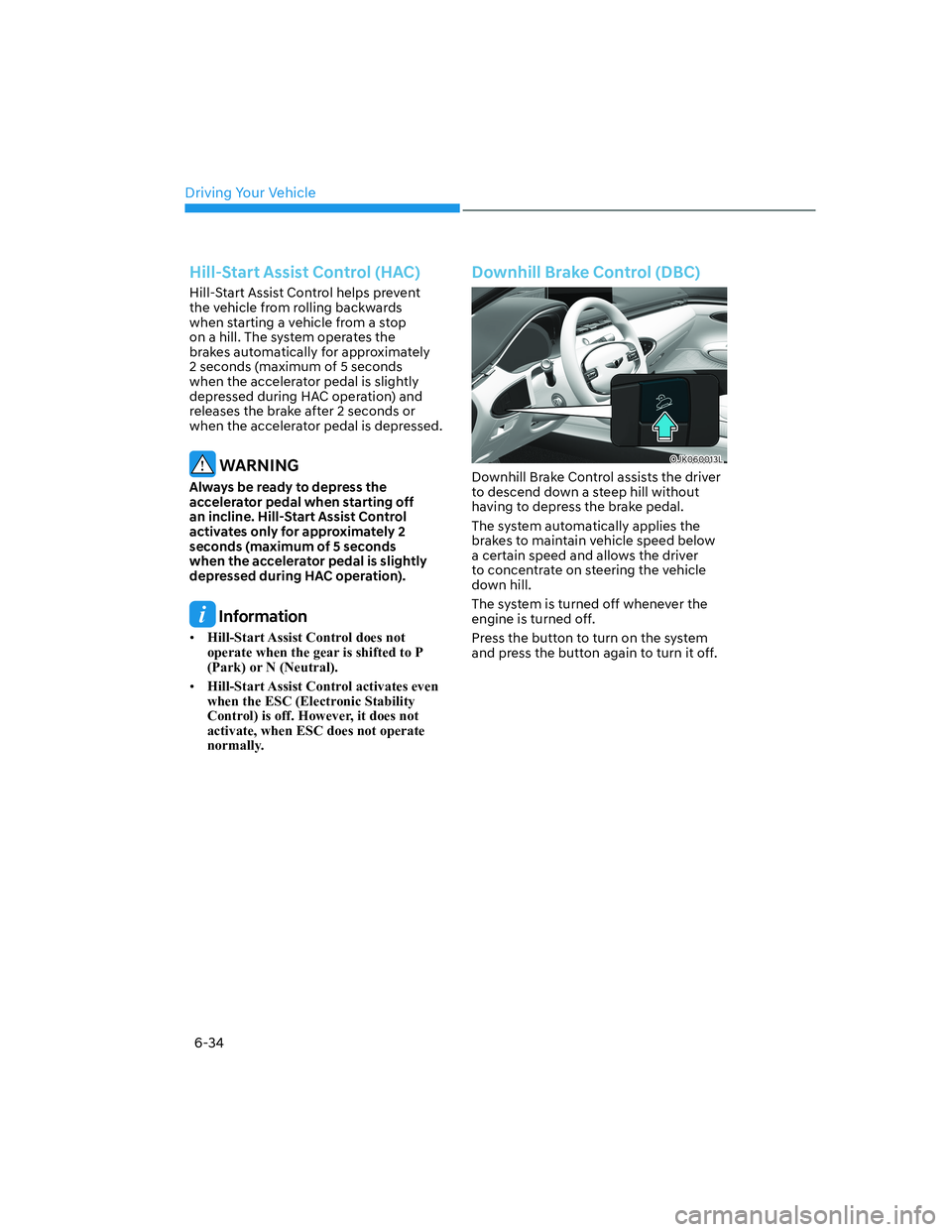
Driving Your Vehicle
6-34
Hill-Start Assist Control (HAC)
Hill-Start Assist Control helps prevent
the vehicle from rolling backwards
when starting a vehicle from a stop
on a hill. The system operates the
brakes automatically for approximately
2 seconds (maximum of 5 seconds
when the accelerator pedal is slightly
depressed during HAC operation) and
releases the brake after 2 seconds or
when the accelerator pedal is depressed.
WARNING
Always be ready to depress the
accelerator pedal when starting off
an incline. Hill-Start Assist Control
activates only for approximately 2
seconds (maximum of 5 seconds
when the accelerator pedal is slightly
depressed during HAC operation).
Information
• Hill-Start Assist Control does not
operate when the gear is shifted to P
(Park) or N (Neutral).
• Hill-Start Assist Control activates even
when the ESC (Electronic Stability
Control) is off. However, it does not
activate, when ESC does not operate
normally.
Downhill Brake Control (DBC)
OJK060013LOJK060013L
Downhill Brake Control assists the driver
to descend down a steep hill without
having to depress the brake pedal.
The system automatically applies the
brakes to maintain vehicle speed below
a certain speed and allows the driver
to concentrate on steering the vehicle
down hill.
The system is turned off whenever the
engine is turned off.
Press the button to turn on the system
and press the button again to turn it off.
Page 309 of 647
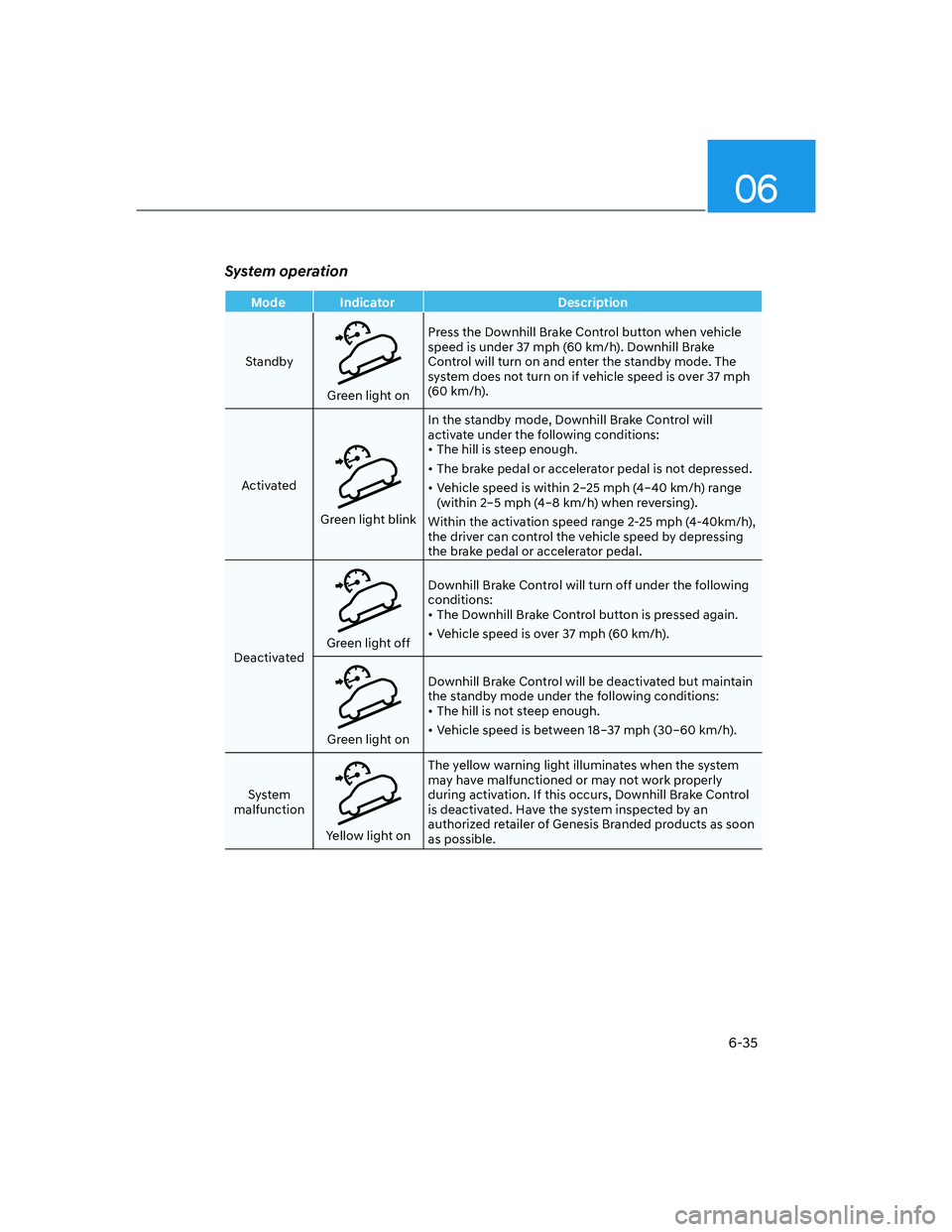
06
6-35
System operation
Mode Indicator Description
Standby
Green light onPress the Downhill Brake Control button when vehicle
speed is under 37 mph (60 km/h). Downhill Brake
Control will turn on and enter the standby mode. The
system does not turn on if vehicle speed is over 37 mph
(60 km/h).
Activated
Green light blinkIn the standby mode, Downhill Brake Control will
activate under the following conditions:
• The hill is steep enough.
• The brake pedal or accelerator pedal is not depressed.
• Vehicle speed is within 2–25 mph (4–40 km/h) range
(within 2–5 mph (4–8 km/h) when reversing).
Within the activation speed range 2-25 mph (4-40km/h),
the driver can control the vehicle speed by depressing
the brake pedal or accelerator pedal.
Deactivated
Green light offDownhill Brake Control will turn off under the following
conditions:
• The Downhill Brake Control button is pressed again.
• Vehicle speed is over 37 mph (60 km/h).
Green light onDownhill Brake Control will be deactivated but maintain
the standby mode under the following conditions:
• The hill is not steep enough.
• Vehicle speed is between 18–37 mph (30–60 km/h).
System
malfunction
Yellow light onThe yellow warning light illuminates when the system
may have malfunctioned or may not work properly
during activation. If this occurs, Downhill Brake Control
is deactivated. Have the system inspected by an
authorized retailer of Genesis Branded products as soon
as possible.
Page 310 of 647
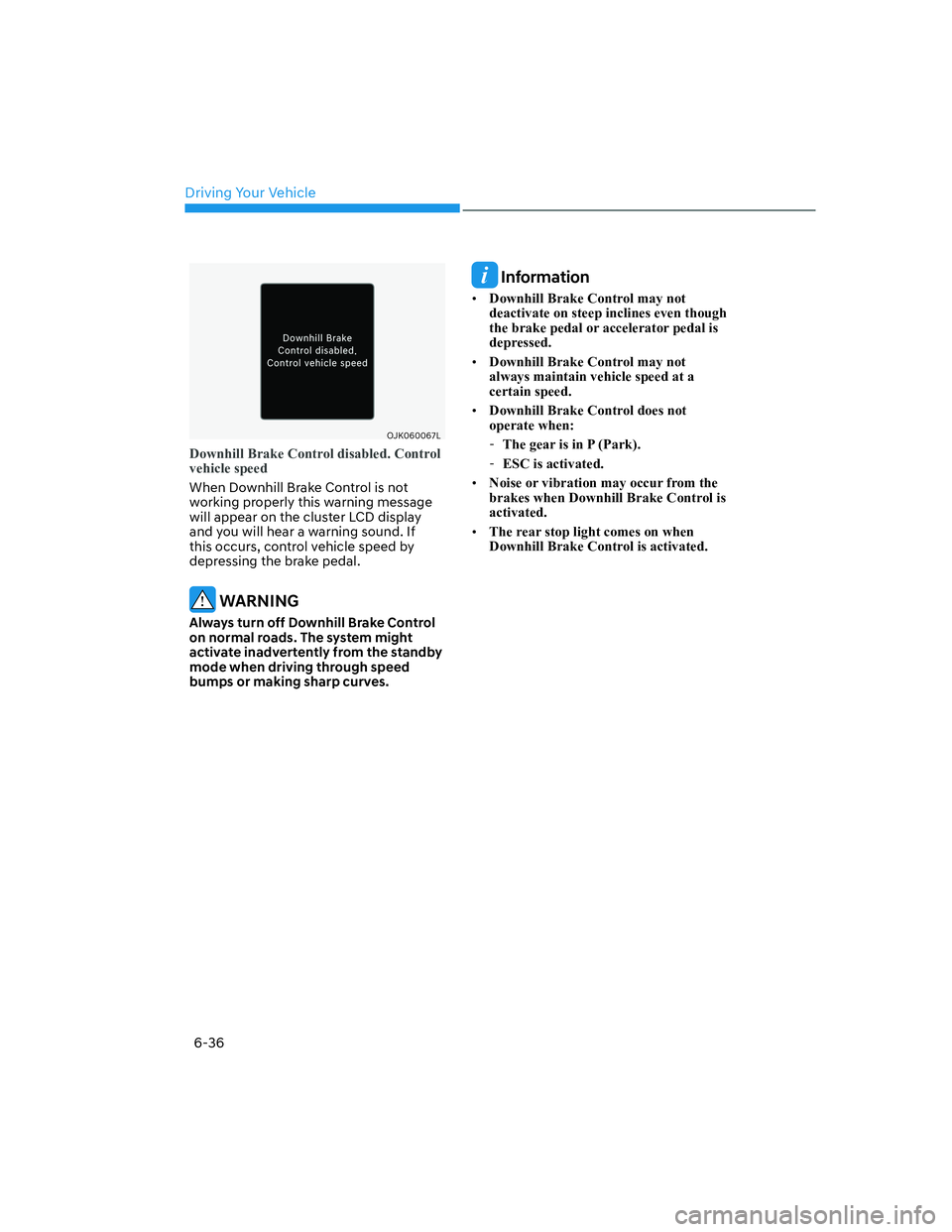
Driving Your Vehicle
6-36
OJK060067LOJK060067L
Downhill Brake Control disabled. Control
vehicle speed
When Downhill Brake Control is not
working properly this warning message
will appear on the cluster LCD display
and you will hear a warning sound. If
this occurs, control vehicle speed by
depressing the brake pedal.
WARNING
Always turn off Downhill Brake Control
on normal roads. The system might
activate inadvertently from the standby
mode when driving through speed
bumps or making sharp curves.
Information
• Downhill Brake Control may not
deactivate on steep inclines even though
the brake pedal or accelerator pedal is
depressed.
• Downhill Brake Control may not
always maintain vehicle speed at a
certain speed.
• Downhill Brake Control does not
operate when:
-The gear is in P (Park).
-ESC is activated.
• Noise or vibration may occur from the
brakes when Downhill Brake Control is
activated.
• The rear stop light comes on when
Downhill Brake Control is activated.